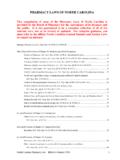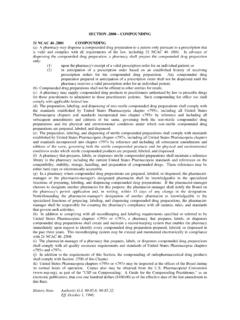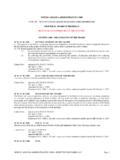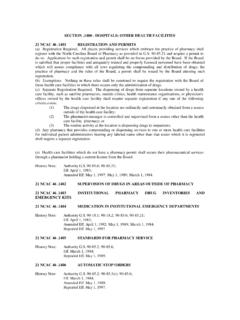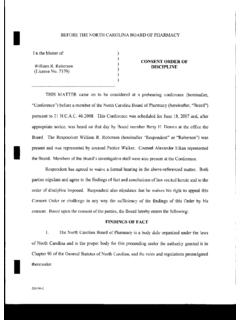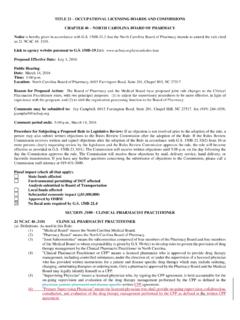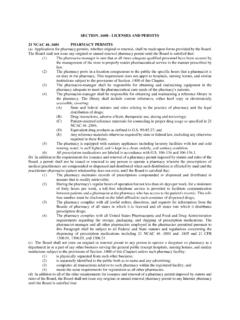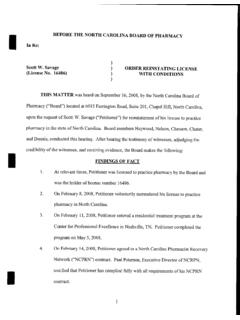Transcription of GUIDANCE TO PHARMACISTS ON IMPLEMENTATION OF …
1 July 20181 GUIDANCE TO PHARMACISTS ON IMPLEMENTATION OF THE strengthen opioid misuse prevention ( STOP ) ACT The North Carolina General Assembly has passed, and the Governor has signed into law, the strengthen opioid misuse prevention ( STOP ) Act. The STOP Act is an effort to combat the opioid abuse and misuse epidemic. The STOP Act makes changes to the laws governing controlled substance prescribing, controlled substance dispensing, and the North Carolina Controlled Substance Reporting System ( CSRS ). This FAQ GUIDANCE discusses those changes. Different parts of the STOP Act go into effect at different times. Here is a timeline of key events (much more information on each is found in the questions below):July 1, 2017 PAs and NPs must personally consult with their supervising physicians prior to prescribing targeted controlled substances in certain circumstances.
2 See Question 7 below. July 1, 2017 Certain hospice or palliative care providers must provide oral and written information to a patient and his/her family regarding proper disposal of targeted controlled substances. See Question 8 below. September 1, 2017 Pharmacies must report required information on all controlled substances dispensed into the CSRS no later than the close of the next business day after dispensing. DHHS gains authority to fine pharmacies who do not report information as required by law to the CSRS. See Question 10 below. November 1, 2017 Board of Pharmacy license renewal period opens. All PHARMACISTS must attest that they have registered for CSRS or are not required by law to do so in order to renew a license for 2018. See Question 11 below.
3 January 1, 2018 Initial prescriptions for targeted controlled substances to treat acute pain limited to a five-day supply; initial prescriptions for targeted controlled substances to treat post -surgical procedure acute pain relief limited to a seven-day supply. See Question 7 January 1, 2020 Prescriptions for targeted controlled substances must be prescribed electronically, with some exceptions. See Question 7 below. * * * July 2017 2 did the Board of Pharmacy pass this law?The Board of Pharmacy did not pass this law. The North Carolina General Assembly passed it, and the Governor signed it into law. the STOP Act affect the practice of pharmacy?Yes, in a number of ways. the STOP Act make changes to PHARMACISTS ability to dispense naloxone, includingby standing order?
4 No. Although the STOP Act includes a new provision that authorizes certain governmental and non-governmental organizations to distribute naloxone, it does not change existing authority for PHARMACISTS to dispense naloxone, including pursuant to the statewide standing order. For more information on the statewide standing order and pharmacist participation, see and the STOP Act make changes to laws governing the prescribing and dispensing of allcontrolled substances?No. The STOP Act makes changes to laws governing the prescribing and dispensing of targeted controlled substances. is a targeted controlled substance ?The STOP Act defines a targeted controlled substance as any controlled substance included in 90-90(1) or (2) or 90-91(d).
5 The controlled substances included are as follows: 90-90(1) & (2). This statutory section includes Schedule II controlled substances that are opioids or opioid derivatives. It does not include Schedule II amphetamine derivatives, barbiturate derivatives, or nabilone derivatives. You may review the list here: 90-91(d). This statutory section includes Schedule III controlled substances that are combination products containing opioids or opioid derivatives. It does not include other Schedule III controlled substances. You may review the list here: July 2017 3 the STOP Act make changes to the way targeted controlled substances areprescribed?Yes. are those changes?Electronic Prescribing Required for Targeted Controlled Substances Effective January 1, 2020, all targeted controlled substances must be prescribed electronically unless an exemption applies.
6 The exemptions include: when a non-pharmacist authorized to do so by law dispenses directly to an ultimate user; orders to administer a targeted controlled substance in a hospital, nursing home, hospice facility, outpatient dialysis facility, or residential care facility; practitioner experiencing a technical failure or other circumstance preventing electronic transmission; prescription to be dispensed by a pharmacy located on federal property; a veterinary prescription. Importantly, however, the STOP Act specifies that a dispensing pharmacist who receives a non-electronic prescription for a targeted controlled substance that otherwise is valid and for a legitimate medical purpose is not required to verify that an exemption to the electronic prescribing requirement applies.
7 Limitations on Initial Prescriptions for a Targeted Controlled Substance to Treat Acute Pain or post -Operative Pain. Effective January 1, 2018, a prescriber may not prescribe more than a five-day supply of a targeted controlled substance upon an initial consultation for acute pain. The STOP Act defines acute pain as pain, whether resulting from disease, accident, intentional trauma, or other cause, that the practitioner expects to last for three months or less. The term does not include chronic pain or pain being treated as part of cancer care, hospice care, palliative care, or medication-assisted treatment for substance use disorder. Similarly, effective January 1, 2018, a prescriber may not prescribe more than an initial seven-day supply of a targeted controlled substance for post -surgical procedure acute pain relief.
8 The STOP Act defines a surgical procedure as one performed for the purpose of structurally altering the human body by incision or destruction of tissues as part of the practice of medicine. Surgical procedure also includes diagnostic or therapeutic treatment of conditions by use of instruments such as lasers, ultrasound, ionizing radiation, scalpels, probes, or needles that cause localized alteration or transportation of live human tissue .. The STOP Act does not prohibit prescribers from issuing additional prescriptions for acute pain or relief of post -operative acute pain upon any subsequent consultation for July 2017 4 the same pain. Importantly, however, the STOP Act specifies that a pharmacist who receives a prescription for greater than a five- or seven-day supply of a targeted controlled substance is not required to verify that it is a prescription to treat something other than acute pain or post -operative acute pain relief.
9 Of course, PHARMACISTS must always exercise professional judgment to determine whether any controlled substance prescription was issued for a legitimate medical purpose in the ordinary course of medical practice. Physician Assistant and Nurse Practitioner Consultation Requirements for Targeted Controlled Substance Prescriptions. Effective July 1, 2017, the STOP Act requires PAs and NPs to personally consult with their supervising physician before prescribing a targeted controlled substance for a patient being treated by a facility that primarily engages in the treatment of pain by prescribing narcotic medications or [that] advertises in any medium for any type of pain management services or if the therapeutic use of the targeted controlled substance will or is expected to exceed 30 days.
10 PHARMACISTS will recall that Medical Board rules already limit PAs and NPs to prescribing a 30-day supply of Schedule II and Schedule III medications. See 21 NCAC (PAs); 21 NCAC (NPs). PAs and NPs may authorize refills on a 30-day supply of a Schedule III medication as permitted by law. Plainly, PHARMACISTS are in no position to determine whether a PA or NP has complied with the consultation requirement in the STOP Act. PHARMACISTS are reminded, however, that when the exercise of professional judgment raises concerns about the validity of a PA s or NP s prescription for a targeted controlled substance (or any other prescription), consulting with the supervising physician is a good step toward resolving such concerns. the STOP Act create requirements for the disposal of targeted controlledsubstances ?
